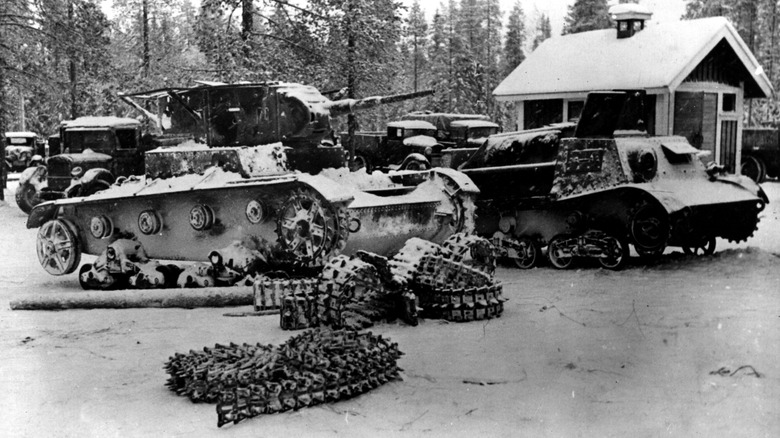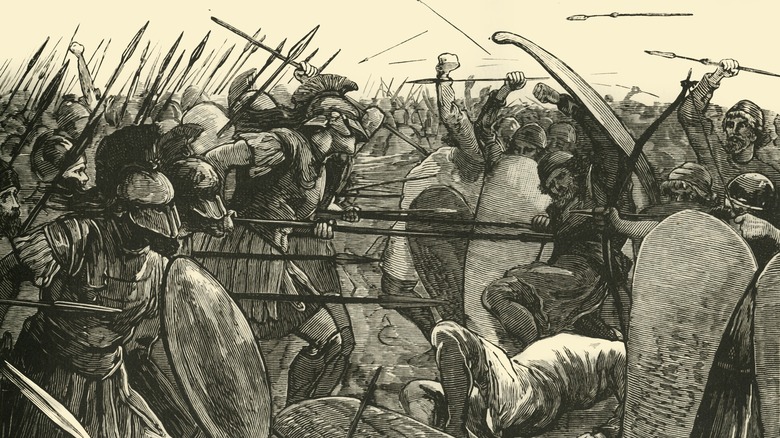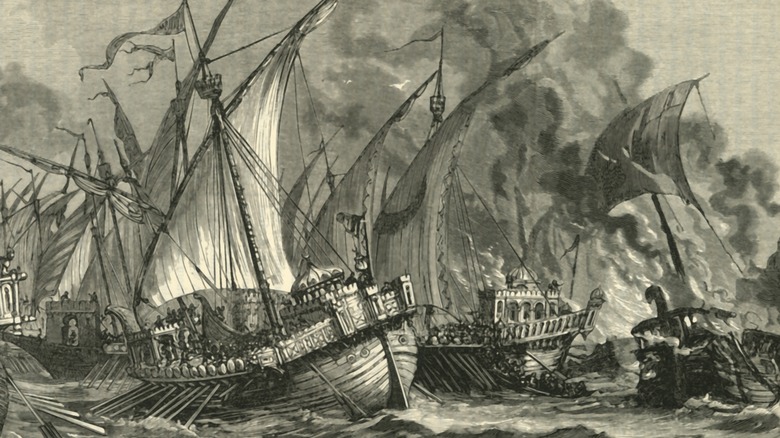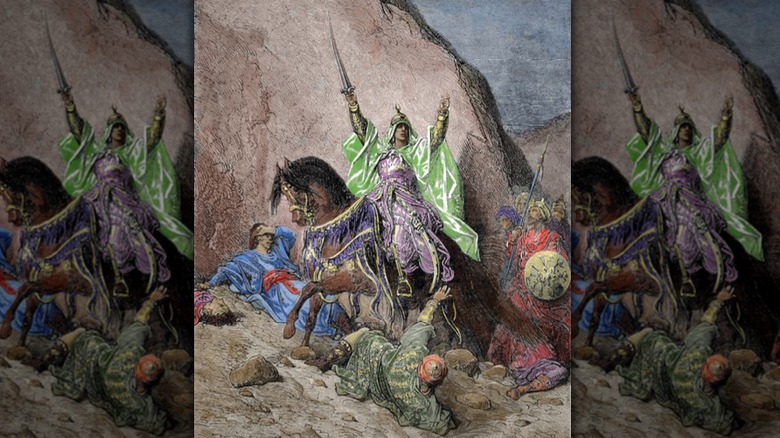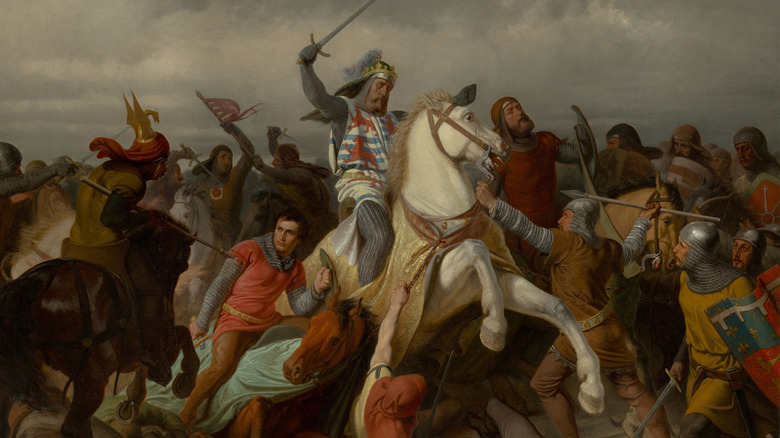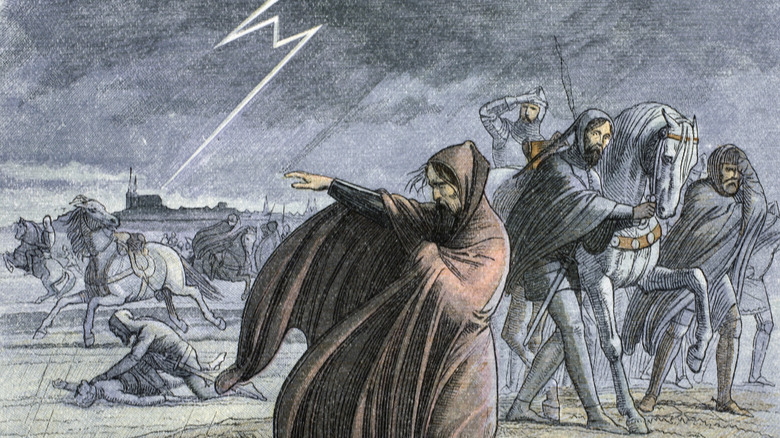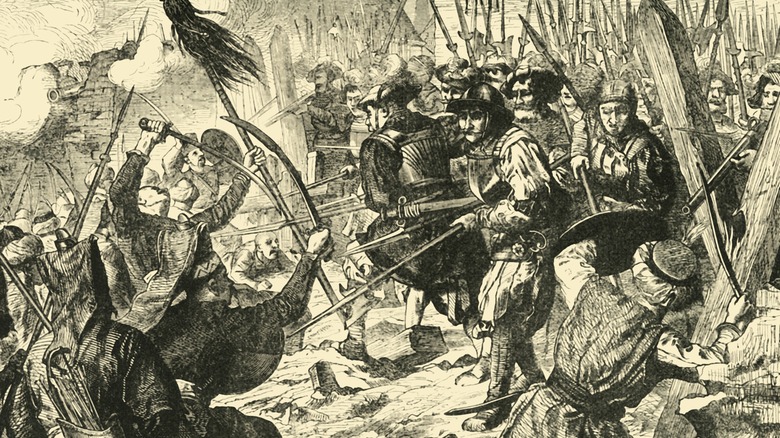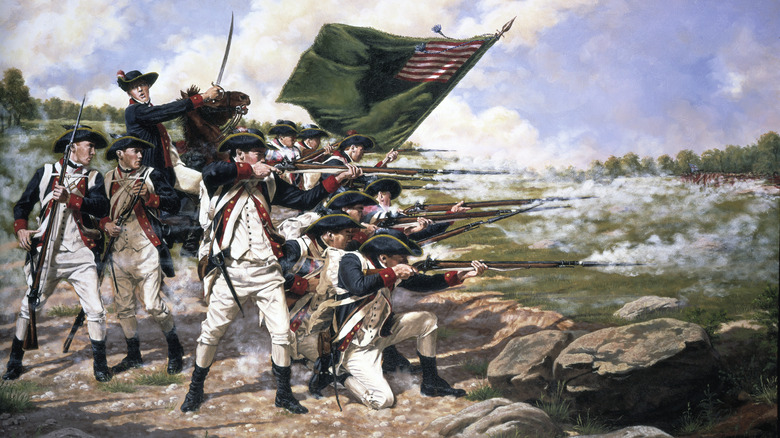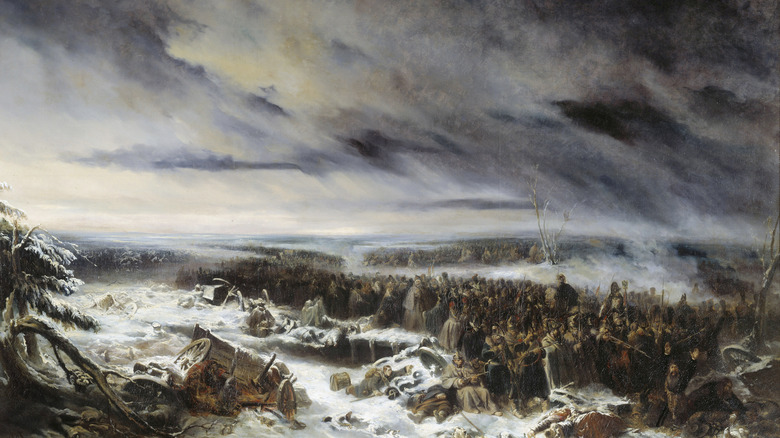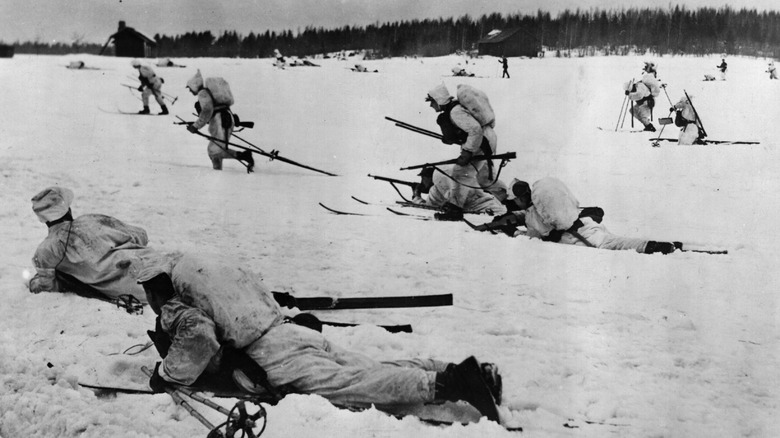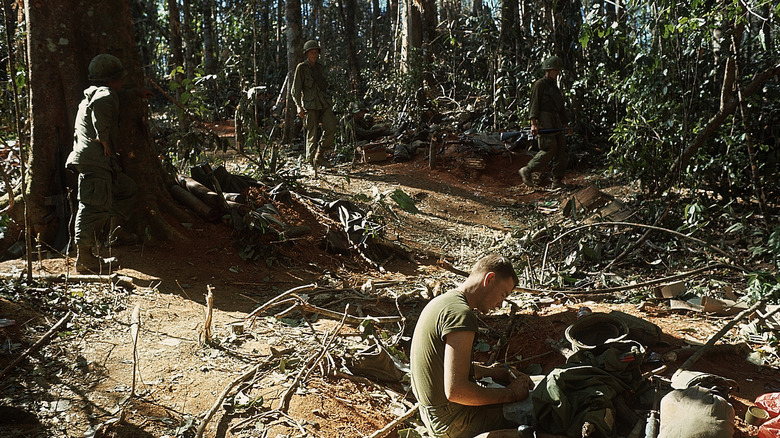10 Times The Weather Turned The Tides Of War
"An army marches on its stomach" — or so the old saying goes. Generally, in war, generals like to keep as many of the circumstances in which they fight under their control. Thus, supply lines, logistics, and tactics are all carefully planned out. But battles rarely, if ever, go exactly as planned. Often, weather throws a wrench into even the best-laid plans, forcing commanders to rethink their entire strategy on the fly or lose the battle (or even the war).
Other times, however, commanders were able to take advantage of the weather to turn a bad situation to their favor. In fact, one can argue that the weather did not make the difference. Rather, it was the commanders who knew how to turn bad weather to their advantage. From one of the earliest recorded tsunamis that destroyed a Persian invasion force in Greece, to a fortuitous fog that saved General George Washington and the United States from destruction just two months after the Declaration of Independence, and more, here are some instances in which weather has made a decisive difference in war.
The Siege of Potidaea (479 BC)
The Greek historian and ethnographer Herodotus recounted in "The Histories" that in 479 BC, the army of Persian Satrap Artabazus laid siege to Potidaea, a city in Northern Greece on the Khalkidhiki Peninsula. Potidaea occupied the narrowest point of the peninsula, which according to Herodotus, appears to have sometimes been underwater. But three months into the siege, the area was a passable marsh.
Herodotus writes that when the Persian army attempted to "pass over it [the marsh] into Pallene" (the peninsula to the south of Potidaea), they encountered an unexpected weather event. As they had gotten almost halfway across the marsh, a massive flood swept the Persians away and drowned most of them. The Potidaeans killed the rest after they sallied forth on ships. The besiegers were forced to abandon the siege and retreat to Thessaly in North-Central Greece.
Herodotus gives a clue as to the cause of the flood. The Potidaeans said that the Persians had offended Poseidon by defacing his temple and image on the city's outskirts. But Poseidon was not a good god to pick a fight with, since he was the god of the sea – and, more importantly, earthquakes. Thus, the god sent the disaster upon the Persians as revenge. Scientists looking at the incident have confirmed that an earthquake was indeed responsible for the tsunami and saved the city from falling to a Persian sack, according to the BBC. So although the Potidaeans did not quite pinpoint the exact cause of the tsunami, they were pretty close.
Siege of Constantinople (860)
The Byzantine capital city of Constantinople is most famous for the final 1453 siege that saw the city fall into Ottoman Turkish hands. But the city had survived numerous sieges before that, including one by Rus' Vikings. The "northmen" were besieging Constantinople and plundering its exurbs, but apart from that, the sources are scant on details. One story suggests the siege ended with divine intervention and bad weather.
The source in question is the Chronicon Bruxellense, which according to the journal Studia Ceranea, contains details that either contradict previous sources or are omitted, despite claims that the author was an eyewitness. The Rus' siege of Constantinople, according to a homily by Patriarch Photios of Constantinople, ended when the "raiment [clothing] of God's Mother [the Virgin Mary]" was placed on the walls. The Rus' warriors inexplicably packed up their camp and left. The Chronicon Bruxellense and its likely antecedent by Symeon the Logothete, however, adds that the Virgin's veil was not simply placed on the walls. Rather, Emperor Michael III dipped it into the waters of the Bosphorus. A miraculous storm then followed, destroying all the Rus' ships.
Ultimately, it is unclear whether the story of the veil has truth to it, since one would expect Patriarch Photios to note such a miracle in his sermon. On the flip side, however, the Orthodox world certainly seems to have believed the story, considering that frescoes of the alleged scene adorn churches in at least one place — Moscow.
Horns of Hattin (1187)
The Horns of Hattin pitted Ayyubid Sultan Saladin against King Guy of the crusader Kingdom of Jerusalem. In 1187, the crusader army was marching to relieve the castle at Tiberius, according to the Warfare History Network. However, instead of attacking immediately, King Guy decided to stop and rest at a place called the Horns of Hattin. There, Saladin had him right where he wanted — and he took full advantage of the midsummer heat.
Saladin made the first move. Because of the heat, the grass around the crusader camp was bone dry. So his soldiers lit it on fire, creating a thick cloud of smoke that blanketed the crusader camp so they could not see that the Ayyubid sultan was enveloping them in the night.
The actual fighting did not start until around midday – the hottest part of the day. The crusaders attacked, hoping to reach Lake Tiberias and restock their water supplies, but Saladin's forces blocked their path. Weighed down by their armor, the heat, sleep deprivation, and all-around exhaustion, the crusaders stood no chance against the lightly-armed and mobile Ayyubid archers. Matters got even worse when the relic of the True Cross was captured, further breaking morale. King Guy and most of his army surrendered and were taken into captivity.
With the victory, Saladin besieged Ascalon and then captured Jerusalem, putting the city back into Muslim hands. But it also instigated the Third Crusade, where the sultan would face a much more formidable opponent than King Guy.
Battle of Crecy (1346)
After Philip IV of France died in 1314, his three sons then died in quick succession without heirs, per the Warfare History Network. The king's closest relative was his nephew Edward III of England, son of his sister Isabella. However, Philip de Valois disputed the claim, arguing that French "loi salique," which prevented women from inheriting the French throne, also prevented them from passing claims. The French nobility sided with him, and he became Philip VI.
Edward was not happy about the outcome, and in 1346, he was finally able to invade France with an army of 12,000 men to make a go for the throne. Opposing him was a 30,000-strong French army, which included large numbers of German and Italian mercenaries.
The French attacked Edward's army near the town of Crecy. Philip began with a crossbow attack, but was unlucky when a sudden rainstorm hit. The Genoese crossbows' strings got wet and could not fire, allowing the English longbowmen, who had kept their strings dry, to shoot them to pieces. Then it was the French knight's turn to attack, but as they charged up the muddy hill against the English positions, they got stuck as English steel-tipped longbows punctured their armor. The battle became a disaster for France, which then lost the port of Calais — an important staging point for future English invasions of the country.
Black Monday (1360)
In 1359, Edward III followed up his victory of Crecy with another full-scale invasion of France – this time targeting Paris itself, per Historic UK. On April 13, 1360 — Easter Sunday — his army, fresh off plundering the outskirts of Paris, was besieging the French city of Chartres. That night, Edward's campaign fell apart after just 30 minutes when a severe weather event suddenly struck his camp. First, the temperature dropped to below freezing, something the English army had not prepared for. Then it rained, which soon turned to massive hail and dangerous winds.
The storm ripped apart the English camp, blowing away tents and frightening horses, which then stampeded around the camp and trampled everyone in their way. The hail, meanwhile, also claimed its share of deaths. Overall, the English lost 1,000 men and 6,000 horses — three times the estimated casualties at the Battle of Crecy.
The English chronicles note that Edward and his men (no doubt noticing the timing of the storm with Easter Sunday) got on their knees and begged for God's mercy. The king concluded that God wanted him to stop the war and decided to negotiate with the French. In May, the two sides signed the Treaty of Bretigny, in which France formally ceded the port of Calais and the southwestern region of Aquitaine to England in return for Edward's renunciation of the French throne. Edward also released the captive French King Jean II — for a hefty ransom, of course.
Siege of Vienna (1529)
The Siege of Vienna usually refers to the 1683 Turkish attack on the Austrian capital, but before that, the city also survived a less-famous Ottoman siege in 1529. Unlike the 1683 battle in which Poland saved the day, the defenders in 1529 owed their success to the weather.
According to historian Karl August Schimmer in his book "The Sieges of Vienna by the Turks," Vienna's defenders in 1529 faced a 300,000-strong Ottoman force under Sultan Suleiman the Magnificent. Despite the odds, Schimmer noted that things were not quite as bad for the defenders as they seemed. The Ottomans had left their heaviest artillery, which they needed to quickly breach Vienna's walls, in Hungary. The late summer rains had been so heavy that it had been impossible to drag them across the muddy roads in time for the attack. Instead, the Ottomans were forced to rely on mining the walls, a job in which skill counted over numbers. The defenders were able to counter-mine and collapse the Ottoman tunnels, which ultimately went nowhere.
Things got worse weather-wise for the attackers, as the early fall of 1529 proved colder than expected and the heavy rains soon turned to nighttime frosts. The Ottomans, who had been expecting a warmer climate, were not prepared for the cold nights as illness, privations of war, and shortages took their toll on the besiegers. Suleiman was eventually forced to abandon the field, but not before he had his soldiers burn their camp, along with all of their prisoners.
Battle of Long Island (1776)
In August 1776, the newly-declared United States found itself fighting the British around New York City and Brooklyn (at the time a separate entity). General George Washington, according to the Mt. Vernon Museum, had hoped that his men could hold the western part of Long Island against British General William Howe. Washington posted his men to guard the entrances to Brooklyn, but he neglected to cover a road called the Jamaica Pass. Howe struck here in a bid to bottle up Washington's forces against the East River.
Howe put his encirclement into action on August 27, with a three-pronged attack that saw American forces forced to retreat to their main position on Brooklyn Heights. From here, there was no place to run but the East River. But just when all seemed lost for Washington, two strokes of luck saved the American cause. First, Howe decided not to assault the American position — an action that might have ended the war then and there, albeit with heavy British casualties. Instead, Howe chose to dig in and starve Washington out.
Washington, for his part, did not give up, and ordered his army on a risky retreat by night as the British were closing the trap. But he got twice lucky. Thanks to a thick fog, the Continental Army's 9,000 men slipped away to Manhattan undisturbed. Washington, like a true leader, was the last American to leave. When the fog lifted on the morning of August 30, the British found that the Americans were all gone.
Napoleon's invasion of Russia (1812)
Common wisdom says that Napoleon's defeat in his 1812 invasion of Russia came from the winter. According to Russia Beyond, however, the whole idea of "General Frost," as the French emperor called the Russian winter, was in part a clever PR move to cover for his own tactical blunders against the Russian army.
As Russia Beyond notes, the French army lost the battle for three reasons: it was undersupplied, reliant on long trade routes, and faced not only the main Russian army, but well-organized guerrilla troops made up of peasants and Cossacks alike. In other words, Napoleon had not adequately prepared to confront the logistical challenges of a winter campaign in Russia, even though he knew of the type of weather he would be facing.
Even though the winter was not solely responsible for stopping Napoleon, its role cannot be completely discarded either. As French General Henri de Jomini noted, the major difference between the Russian campaign and other winter campaigns was that before, French soldiers were well-nourished, keeping them in fighting shape despite the cold. In Russia, however, French soldiers could not live off the land, leading to poorly-nourished soldiers who were not in shape to fight. Throw on the winter cold, and the French had a disaster on their hands, since good nutrition is always essential to maintaining an army in fighting shape, and more so in winter.
Battle of Suomussalmi (1939)
When the USSR invaded Finland in 1939, the Finns mounted a heroic defense of their independence under Field Marshal Carl Emil Gustaf Mannerheim. Their successes came mostly from their mastery of the brutal winter weather of 1939, when temperatures regularly hit -30F, according to William Trotter's "A Frozen Hell."
The Finnish advantage played out most visibly on the Arctic front of the war in eastern Finland. Here, the Finns, without a single anti-tank gun, faced Soviet soldiers armed to the teeth with tanks and armored vehicles. But for all their fancy equipment, the Soviets were crushed at the Battle of Suomussalmi, where their superior firepower was useless against the Finns and "General Winter." As Trotter explains, the Soviet soldiers were not equipped for arctic warfare: Their diet and clothing were insufficient. The snow and few roads made moving vehicles and tanks nearly impossible — assuming their batteries did not run dry in the cold first — and Soviet soldiers' khaki uniforms made them sitting ducks for mobile Finnish ski troops clad in all-white.
At Suomussalmi, the Finns made full use of their advantage. Finnish gunners would block the roads, forcing the Soviets to either charge through the lines, or take circuitous detours through snowy woods. There, Finnish ski troops armed with every manner of grenade and explosive would swarm the Soviets and then disappear into the snow. In this way, just a few Finnish battalions were able to destroy entire Soviet divisions, earning the Finns the nickname "the White Death."
Vietnam (1955-75)
When the United States emerged victorious from World War II — a fairly conventional war in most respects — a sense of invincibility pervaded the world's foremost superpower. That was soon shattered, however, when the United States became involved in a completely different type of conflict it was not prepared to fight, in large part due to weather: Vietnam.
Vietnam was a completely different ballgame from World War II, which had been fought on the open fields of Europe against similar opponents, per Princeton. Instead of a large enemy army out in the open, the United States faced a well-organized army of enemy guerrillas fighting in the thick jungles of Vietnam, where the weather and terrain nullified virtually every American advantage.
Foremost among the Americans' problems was Vietnam's two-season weather — the monsoon season and the dry season. During the monsoon season, high winds and heavy rains made it impossible to provide soldiers on the ground with any sort of air support, whether from planes or helicopters. On the ground, the hot, damp climate created the perfect breeding ground for diseases such as malaria. According to the Australian Department of Veterans' Affairs, the rain also made American armored vehicles — one place where the Americans outgunned the Vietnamese — completely useless in the wet, muddy terrain. The dry season did not provide much respite, either. Dust storms caused all sorts of eye and ear infections for crews working inside metal vehicles, whose interior temperature regularly went above 100 F. Given the conditions, it is unsurprising that support for the war was so low at home.
